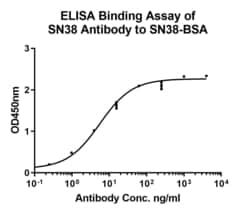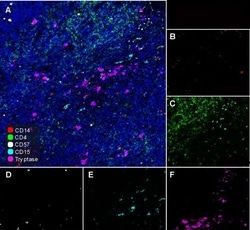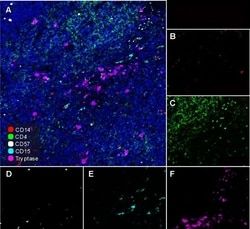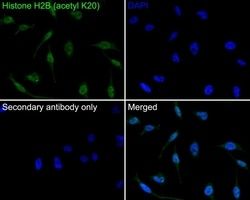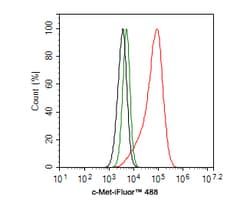FEMA550785
BrdU Recombinant Rabbit Monoclonal Antibody (PSH0-18), Invitrogen™
Manufacturer: Thermo Scientific
Select a Size
| Pack Size | SKU | Availability | Price |
|---|---|---|---|
| Each of 1 | FEMA550785-Each-of-1 | In Stock | ₹ 42,275.00 |
FEMA550785 - Each of 1
In Stock
Quantity
1
Base Price: ₹ 42,275.00
GST (18%): ₹ 7,609.50
Total Price: ₹ 49,884.50
Antigen
BrdU
Classification
Recombinant Monoclonal
Concentration
1 mg/mL
Formulation
PBS with 0.1% BSA, 40% glycerol and 0.05% sodium azide; pH 7.4
Host Species
Rabbit
Purification Method
Protein A
Regulatory Status
RUO
Target Species
Chemical, Rabbit
Form
Liquid
Target Molecule
Rabbit
Applications
Flow Cytometry, Immunocytochemistry, Immunohistochemistry (Paraffin)
Clone
PSH0-18
Conjugate
Unconjugated
Gene Alias
5-Bromo-2-deoxyuridine, Bromodeoxyuridine
Immunogen
BrdU-OVA
Quantity
100 μL
Primary or Secondary
Primary
Content And Storage
Store at 4°C short term. For long term storage, store at -20°C, avoiding freeze/thaw cycles.
Isotype
IgG
Description
- Positive control: BrdU treated mouse embryo tissue, BrdU treated NIH/3T3
- Subcellular Location: Nucleus
- Bromodeoxyuridine (5-bromo-2-deoxyuridine, BrdU) is a synthetic nucleoside that is an analogue of thymidine
- BrdU is commonly used in the detection of proliferating cells in living tissues, and can be incorporated into the newly synthesized DNA of replicating cells (during the S phase of the cell cycle), substituting for thymidine during DNA replication
- Antibodies specific for BrdU can then be used to detect the incorporated chemical, thus indicating cells that were actively replicating their DNA
- Binding of the antibody requires denaturation of the DNA, usually by exposing the cells to acid or heat.
Compare Similar Items
Show Difference
Antigen: BrdU
Classification: Recombinant Monoclonal
Concentration: 1 mg/mL
Formulation: PBS with 0.1% BSA, 40% glycerol and 0.05% sodium azide; pH 7.4
Host Species: Rabbit
Purification Method: Protein A
Regulatory Status: RUO
Target Species: Chemical, Rabbit
Form: Liquid
Target Molecule: Rabbit
Applications: Flow Cytometry, Immunocytochemistry, Immunohistochemistry (Paraffin)
Clone: PSH0-18
Conjugate: Unconjugated
Gene Alias: 5-Bromo-2-deoxyuridine, Bromodeoxyuridine
Immunogen: BrdU-OVA
Quantity: 100 μL
Primary or Secondary: Primary
Content And Storage: Store at 4°C short term. For long term storage, store at -20°C, avoiding freeze/thaw cycles.
Isotype: IgG
Antigen:
BrdU
Classification:
Recombinant Monoclonal
Concentration:
1 mg/mL
Formulation:
PBS with 0.1% BSA, 40% glycerol and 0.05% sodium azide; pH 7.4
Host Species:
Rabbit
Purification Method:
Protein A
Regulatory Status:
RUO
Target Species:
Chemical, Rabbit
Form:
Liquid
Target Molecule:
Rabbit
Applications:
Flow Cytometry, Immunocytochemistry, Immunohistochemistry (Paraffin)
Clone:
PSH0-18
Conjugate:
Unconjugated
Gene Alias:
5-Bromo-2-deoxyuridine, Bromodeoxyuridine
Immunogen:
BrdU-OVA
Quantity:
100 μL
Primary or Secondary:
Primary
Content And Storage:
Store at 4°C short term. For long term storage, store at -20°C, avoiding freeze/thaw cycles.
Isotype:
IgG
Antigen: H2BK20ac
Classification: Recombinant Monoclonal
Concentration: 1 mg/mL
Formulation: PBS with 0.1% BSA, 40% glycerol and 0.05% sodium azide; pH 7.4
Host Species: Rabbit
Purification Method: Protein A
Regulatory Status: RUO
Target Species: Human, Mouse, Rat
Form: Liquid
Target Molecule: __
Applications: Immunocytochemistry, Immunohistochemistry (Paraffin), Western Blot
Clone: PS01-46
Conjugate: Unconjugated
Gene Alias: 2610022J01Rik, Acetyl-Histone H2, Acetyl-Histone H2B K20, Acetyl-Histone H2B Lys20, AV127319, bA317E16.3, dJ160A22.3, dJ193B12.2, dJ221C16.3, dJ221C16.6, dJ221C16.8, dJ97D16.4, GL105, H2B, H2B 291A, H2B 291B, H2b 613, H2B GL105, H2B histone family member M, H2B histone family member W testis-specific, H2B histone family member W, testis specific, H2B histone family, member A, H2B histone family, member B, H2B histone family, member C, H2B histone family, member D, H2B histone family, member E, H2B histone family, member F, H2B histone family, member J, H2B histone family, member K, H2B histone family, member L, H2B histone family, member M, H2B histone family, member N, H2B histone family, member Q, H2B histone family, member R, H2B histone family, member S, H2B histone family, member T, H2B histone family, member U, (testis-specific), H2B histone family, member W, testis-specific, H2B K, H2B type 12, H2B.1, H2B.1A, H2B.1B, H2B.2, H2B/a, H2B/b, H2B/c, H2B/d, H2B/e, H2B/f, H2B/g, H2B/h, H2B/I, H2B/j, H2B/k, H2B/l, H2B/n, H2B/q, H2B/r, H2B/S, h2B-143, h2B-221, H2b-291b, H2b-613, H2Bb, H2BC10, H2BC4, H2BC6, H2BC7, H2BC8, H2b-f, H2BFA, H2BFAiii, H2BFB, H2BFC, H2BFD, H2BFE, H2BFF, H2BFG, H2BFH, H2BFJ, H2BFK, H2BFL, H2BFM, H2BFN, H2BFQ, H2BFR, H2bfs, H2BFT, H2BFU, H2BFWT, H2BGL105, H2BJ, H2b-j, H2BK, H2BK12ac, H2BK15ac, H2BK5ac, H2b-l, H2BLys20ac, H2b-n, H2BQ, H2BS14, H2BS14p, HIRA-interacting protein 1, HIRA-interacting protein 2, HIRIP1, HIRIP2, HIST1H2BA, HIST1H2BB, HIST1H2BC, HIST1H2BD, Hist1h2be, Hist1h2bf, HIST1H2BG, Hist1h2bh, HIST1H2BI, Hist1h2bj, Hist1h2bk, HIST1H2BL, Hist1h2bm, Hist1h2bn, HIST1H2BO, HIST1H3I, Hist2h2be, HIST2H2BF, Hist3h2bb, histone 1, H2ba, histone 1, H2bb, histone 1, H2bc, histone 1, H2bd, histone 1, H2bg, histone 1, H2bh, histone 1, H2bi, histone 1, H2bj, histone 1, H2bk, histone 1, H2bl, histone 1, H2bm, histone 1, H2bn, histone 1, H2bo, histone 2, H2be, Histone 2B, histone 3, H2bb, histone cluster 1, H2ba, histone cluster 1, H2bb, histone cluster 1, H2bc, histone cluster 1, H2bd, histone cluster 1, H2bg, histone cluster 1, H2bh, histone cluster 1, H2bi, histone cluster 1, H2bj, histone cluster 1, H2bk, histone cluster 1, H2bl, histone cluster 1, H2bm, histone cluster 1, H2bn, histone cluster 1, H2bo, histone cluster 2, H2be, histone cluster 2, H2bf, histone cluster 3, H2bb, histone family member, histone H2B, histone H2B type 1-A, Histone H2B type 1-B, histone H2B type 1-C/E/F/G/I, Histone H2B type 1-C/E/G, histone H2B type 1-D, Histone H2B type 1-F/J/L, histone H2B type 1-H, Histone H2B type 1-J, histone H2B type 1-K, Histone H2B type 1-L, histone H2B type 1-M, Histone H2B type 1-N, histone H2B type 1-O, Histone H2B type 2-E, histone H2B type 2-F, Histone H2B type 3-B, histone H2B type F-M, Histone H2B type F-S, histone H2B type F-S-like, histone H2B type W-T, Histone H2B, testis, Histone H2B.1, histone H2B.1 A, Histone H2B.1 B, histone H2B.2, Histone H2B.a, histone H2B.b, Histone H2B.c, histone H2B.d, Histone H2B.e, histone H2B.f, Histone H2B.g, Histone H2B.h, Histone H2B.I, Histone H2B.j, histone H2B.k, Histone H2B.l, histone H2B.n, Histone H2B.q, histone H2B.r, Histone H2B.s, histone H2B-GL105, LOC102724334, MGC125414, MGC125415, MGC125416, MGC9388, R74621, RP1-193B12.10, STBP, T25626, testis-specific histone 2b, testis-specific histone H2B, Th2b, TSH2B, TSH2B.1
Immunogen: Synthetic peptide surrounding acetylated Lys5 of human histone H2B protein.
Quantity: 100 μL
Primary or Secondary: Primary
Content And Storage: Store at 4°C short term. For long term storage, store at -20°C, avoiding freeze/thaw cycles.
Isotype: IgG
Antigen:
H2BK20ac
Classification:
Recombinant Monoclonal
Concentration:
1 mg/mL
Formulation:
PBS with 0.1% BSA, 40% glycerol and 0.05% sodium azide; pH 7.4
Host Species:
Rabbit
Purification Method:
Protein A
Regulatory Status:
RUO
Target Species:
Human, Mouse, Rat
Form:
Liquid
Target Molecule:
__
Applications:
Immunocytochemistry, Immunohistochemistry (Paraffin), Western Blot
Clone:
PS01-46
Conjugate:
Unconjugated
Gene Alias:
2610022J01Rik, Acetyl-Histone H2, Acetyl-Histone H2B K20, Acetyl-Histone H2B Lys20, AV127319, bA317E16.3, dJ160A22.3, dJ193B12.2, dJ221C16.3, dJ221C16.6, dJ221C16.8, dJ97D16.4, GL105, H2B, H2B 291A, H2B 291B, H2b 613, H2B GL105, H2B histone family member M, H2B histone family member W testis-specific, H2B histone family member W, testis specific, H2B histone family, member A, H2B histone family, member B, H2B histone family, member C, H2B histone family, member D, H2B histone family, member E, H2B histone family, member F, H2B histone family, member J, H2B histone family, member K, H2B histone family, member L, H2B histone family, member M, H2B histone family, member N, H2B histone family, member Q, H2B histone family, member R, H2B histone family, member S, H2B histone family, member T, H2B histone family, member U, (testis-specific), H2B histone family, member W, testis-specific, H2B K, H2B type 12, H2B.1, H2B.1A, H2B.1B, H2B.2, H2B/a, H2B/b, H2B/c, H2B/d, H2B/e, H2B/f, H2B/g, H2B/h, H2B/I, H2B/j, H2B/k, H2B/l, H2B/n, H2B/q, H2B/r, H2B/S, h2B-143, h2B-221, H2b-291b, H2b-613, H2Bb, H2BC10, H2BC4, H2BC6, H2BC7, H2BC8, H2b-f, H2BFA, H2BFAiii, H2BFB, H2BFC, H2BFD, H2BFE, H2BFF, H2BFG, H2BFH, H2BFJ, H2BFK, H2BFL, H2BFM, H2BFN, H2BFQ, H2BFR, H2bfs, H2BFT, H2BFU, H2BFWT, H2BGL105, H2BJ, H2b-j, H2BK, H2BK12ac, H2BK15ac, H2BK5ac, H2b-l, H2BLys20ac, H2b-n, H2BQ, H2BS14, H2BS14p, HIRA-interacting protein 1, HIRA-interacting protein 2, HIRIP1, HIRIP2, HIST1H2BA, HIST1H2BB, HIST1H2BC, HIST1H2BD, Hist1h2be, Hist1h2bf, HIST1H2BG, Hist1h2bh, HIST1H2BI, Hist1h2bj, Hist1h2bk, HIST1H2BL, Hist1h2bm, Hist1h2bn, HIST1H2BO, HIST1H3I, Hist2h2be, HIST2H2BF, Hist3h2bb, histone 1, H2ba, histone 1, H2bb, histone 1, H2bc, histone 1, H2bd, histone 1, H2bg, histone 1, H2bh, histone 1, H2bi, histone 1, H2bj, histone 1, H2bk, histone 1, H2bl, histone 1, H2bm, histone 1, H2bn, histone 1, H2bo, histone 2, H2be, Histone 2B, histone 3, H2bb, histone cluster 1, H2ba, histone cluster 1, H2bb, histone cluster 1, H2bc, histone cluster 1, H2bd, histone cluster 1, H2bg, histone cluster 1, H2bh, histone cluster 1, H2bi, histone cluster 1, H2bj, histone cluster 1, H2bk, histone cluster 1, H2bl, histone cluster 1, H2bm, histone cluster 1, H2bn, histone cluster 1, H2bo, histone cluster 2, H2be, histone cluster 2, H2bf, histone cluster 3, H2bb, histone family member, histone H2B, histone H2B type 1-A, Histone H2B type 1-B, histone H2B type 1-C/E/F/G/I, Histone H2B type 1-C/E/G, histone H2B type 1-D, Histone H2B type 1-F/J/L, histone H2B type 1-H, Histone H2B type 1-J, histone H2B type 1-K, Histone H2B type 1-L, histone H2B type 1-M, Histone H2B type 1-N, histone H2B type 1-O, Histone H2B type 2-E, histone H2B type 2-F, Histone H2B type 3-B, histone H2B type F-M, Histone H2B type F-S, histone H2B type F-S-like, histone H2B type W-T, Histone H2B, testis, Histone H2B.1, histone H2B.1 A, Histone H2B.1 B, histone H2B.2, Histone H2B.a, histone H2B.b, Histone H2B.c, histone H2B.d, Histone H2B.e, histone H2B.f, Histone H2B.g, Histone H2B.h, Histone H2B.I, Histone H2B.j, histone H2B.k, Histone H2B.l, histone H2B.n, Histone H2B.q, histone H2B.r, Histone H2B.s, histone H2B-GL105, LOC102724334, MGC125414, MGC125415, MGC125416, MGC9388, R74621, RP1-193B12.10, STBP, T25626, testis-specific histone 2b, testis-specific histone H2B, Th2b, TSH2B, TSH2B.1
Immunogen:
Synthetic peptide surrounding acetylated Lys5 of human histone H2B protein.
Quantity:
100 μL
Primary or Secondary:
Primary
Content And Storage:
Store at 4°C short term. For long term storage, store at -20°C, avoiding freeze/thaw cycles.
Isotype:
IgG
Antigen: TNF alpha
Classification: Recombinant Monoclonal
Concentration: 1 mg/mL
Formulation: PBS with 0.1% BSA, 40% glycerol and 0.05% sodium azide; pH 7.4
Host Species: Rabbit
Purification Method: Protein A
Regulatory Status: RUO
Target Species: Human
Form: Liquid
Target Molecule: __
Applications: Immunohistochemistry (Paraffin)
Clone: PS00-40
Conjugate: Unconjugated
Gene Alias: APC1 protein, Cachectin, C-domain 1, C-domain 2, cTNF, DADB-70P7.1, DIF, ICD1, ICD2, Intracellular domain 1, Intracellular domain 2, N-terminal fragment, NTF, RATTNF, Tnf, TNF alpha, TNF superfamily, TNF a, TNF, macrophage-derived, TNF, monocyte-derived, TNFA, TNF-a, TNFalpha, TNF-alpha, Tnfsf1a, TNFSF2, TNFa, TNLG1F, Tumor necrosis factor, tumor necrosis factor (TNF superfamily, member 2), tumor necrosis factor alpha, tumor necrosis factor alpha (cachetin), tumor necrosis factor alpha precursor, tumor necrosis factor ligand 1F, tumor necrosis factor ligand superfamily member 2, Tumor necrosis factor, membrane form, Tumor necrosis factor, soluble form, tumor necrosis factor-alpha, tumor necrosis factor-alpha precursor, tumor-necrosis factor, tumour necrosis factor
Immunogen: Recombinant protein within full length protein aa 1-233/233.
Quantity: 100 μL
Primary or Secondary: Primary
Content And Storage: Store at 4°C short term. For long term storage, store at -20°C, avoiding freeze/thaw cycles.
Isotype: IgG
Antigen:
TNF alpha
Classification:
Recombinant Monoclonal
Concentration:
1 mg/mL
Formulation:
PBS with 0.1% BSA, 40% glycerol and 0.05% sodium azide; pH 7.4
Host Species:
Rabbit
Purification Method:
Protein A
Regulatory Status:
RUO
Target Species:
Human
Form:
Liquid
Target Molecule:
__
Applications:
Immunohistochemistry (Paraffin)
Clone:
PS00-40
Conjugate:
Unconjugated
Gene Alias:
APC1 protein, Cachectin, C-domain 1, C-domain 2, cTNF, DADB-70P7.1, DIF, ICD1, ICD2, Intracellular domain 1, Intracellular domain 2, N-terminal fragment, NTF, RATTNF, Tnf, TNF alpha, TNF superfamily, TNF a, TNF, macrophage-derived, TNF, monocyte-derived, TNFA, TNF-a, TNFalpha, TNF-alpha, Tnfsf1a, TNFSF2, TNFa, TNLG1F, Tumor necrosis factor, tumor necrosis factor (TNF superfamily, member 2), tumor necrosis factor alpha, tumor necrosis factor alpha (cachetin), tumor necrosis factor alpha precursor, tumor necrosis factor ligand 1F, tumor necrosis factor ligand superfamily member 2, Tumor necrosis factor, membrane form, Tumor necrosis factor, soluble form, tumor necrosis factor-alpha, tumor necrosis factor-alpha precursor, tumor-necrosis factor, tumour necrosis factor
Immunogen:
Recombinant protein within full length protein aa 1-233/233.
Quantity:
100 μL
Primary or Secondary:
Primary
Content And Storage:
Store at 4°C short term. For long term storage, store at -20°C, avoiding freeze/thaw cycles.
Isotype:
IgG
Antigen: c-Met
Classification: Recombinant Monoclonal
Concentration: 1 mg/mL
Formulation: PBS with 0.1% BSA, 40% glycerol and 0.05% sodium azide; pH 7.4
Host Species: Rabbit
Purification Method: Protein A
Regulatory Status: RUO
Target Species: Human
Form: Liquid
Target Molecule: __
Applications: Flow Cytometry, Immunohistochemistry (Paraffin), Western Blot
Clone: PSH0-19
Conjugate: Unconjugated
Gene Alias: AI838057, AUTS9, bHLHe59, CG1705, CG1705-PA, CG1705-PB, cmet, c-met, c-met proto-oncogene, c-Met receptor tyrosine kinase, c-Met/HGF receptor, D249, DFNB97, Dmel\CG1705, Dmel_CG1705, DmMet, EC 2.7.10.1, Hepatocyte growth factor receptor, HGF, HGF receptor, HGF receptor c-Met, HGF/SF receptor, HGFR, HGF-SF receptor, juvenile hormone resistance, met, met proto-oncogene, met proto-oncogene (hepatocyte growth factor receptor), met proto-oncogene tyrosine kinase, MET proto-oncogene, receptor tyrosine kinase, Met/Met1, Met, protein tyrosin kinase, methoprene tolerant, Methoprene-tolerant, Methoprene-tolerant protein, Met-PA, Met-PB, Mett, oncogene MET, Par4, Proto-oncogene c-Met, RCCP2, resistance (1) juvenile H, resistance to juvenile hormone, Rst(1)JH, sc MET, scatter factor receptor, SF receptor, soluble c met, tyrosine-protein kinase Met
Immunogen: Synthetic peptide within human Met aa 1341-1390/1390.
Quantity: 100 μL
Primary or Secondary: Primary
Content And Storage: Store at 4°C short term. For long term storage, store at -20°C, avoiding freeze/thaw cycles.
Isotype: IgG
Antigen:
c-Met
Classification:
Recombinant Monoclonal
Concentration:
1 mg/mL
Formulation:
PBS with 0.1% BSA, 40% glycerol and 0.05% sodium azide; pH 7.4
Host Species:
Rabbit
Purification Method:
Protein A
Regulatory Status:
RUO
Target Species:
Human
Form:
Liquid
Target Molecule:
__
Applications:
Flow Cytometry, Immunohistochemistry (Paraffin), Western Blot
Clone:
PSH0-19
Conjugate:
Unconjugated
Gene Alias:
AI838057, AUTS9, bHLHe59, CG1705, CG1705-PA, CG1705-PB, cmet, c-met, c-met proto-oncogene, c-Met receptor tyrosine kinase, c-Met/HGF receptor, D249, DFNB97, Dmel\CG1705, Dmel_CG1705, DmMet, EC 2.7.10.1, Hepatocyte growth factor receptor, HGF, HGF receptor, HGF receptor c-Met, HGF/SF receptor, HGFR, HGF-SF receptor, juvenile hormone resistance, met, met proto-oncogene, met proto-oncogene (hepatocyte growth factor receptor), met proto-oncogene tyrosine kinase, MET proto-oncogene, receptor tyrosine kinase, Met/Met1, Met, protein tyrosin kinase, methoprene tolerant, Methoprene-tolerant, Methoprene-tolerant protein, Met-PA, Met-PB, Mett, oncogene MET, Par4, Proto-oncogene c-Met, RCCP2, resistance (1) juvenile H, resistance to juvenile hormone, Rst(1)JH, sc MET, scatter factor receptor, SF receptor, soluble c met, tyrosine-protein kinase Met
Immunogen:
Synthetic peptide within human Met aa 1341-1390/1390.
Quantity:
100 μL
Primary or Secondary:
Primary
Content And Storage:
Store at 4°C short term. For long term storage, store at -20°C, avoiding freeze/thaw cycles.
Isotype:
IgG





